A surprise in the LUNT CaK wedge
- sullij1
- Way More Fun to Share It!!

- Posts: 2249
- Joined: Wed Mar 28, 2012 4:29 am
- Been thanked: 1 time
Re: A surprise in the LUNT CaK wedge
BTW the OmegaBob CaK pair starts as a 10nm Full Width (FW) cut so 393.4nm/10nm FW. I don't know where this fits into the math.
BTW,Omega bob reports 4nm passband at FWHM and the filter FW at base looks to be around 10nm.
Omega pair data:
http://www.ebay.com/itm/Optical-Filter- ... 484c3173ce
BTW,Omega bob reports 4nm passband at FWHM and the filter FW at base looks to be around 10nm.
Omega pair data:
http://www.ebay.com/itm/Optical-Filter- ... 484c3173ce
Last edited by sullij1 on Tue Mar 18, 2014 7:04 pm, edited 1 time in total.
Look Up!
- marktownley
- Librarian

- Posts: 42559
- Joined: Tue Oct 18, 2011 5:27 pm
- Location: Brierley Hills, UK
- Has thanked: 20828 times
- Been thanked: 10502 times
- Contact:
Re: A surprise in the LUNT CaK wedge
You've been busy there Joe! I have BG25 in my CaK stack now, and in the next hour or two will know whether it has a positive impact on reflections...

http://brierleyhillsolar.blogspot.co.uk/
Solar images, a collection of all the most up to date live solar data on the web, imaging & processing tutorials - please take a look!
- solarchat
- Site Admin

- Posts: 4381
- Joined: Sat Feb 01, 2014 3:10 pm
- Location: Atlanta, GA USA
- Has thanked: 84 times
- Been thanked: 1387 times
- Contact:
Re: A surprise in the LUNT CaK wedge
Jim/Joe,
Ive met you in person and I am certain that you have a much higher retardation value...lol
Just kidding man, I love your motivation and inquisitiveness. You missed your calling and were born 500 years too early my friend.
Ive met you in person and I am certain that you have a much higher retardation value...lol
Just kidding man, I love your motivation and inquisitiveness. You missed your calling and were born 500 years too early my friend.
Stephen W. Ramsden
Atlanta, GA USA
Founder/Director Charlie Bates Solar Astronomy Project
http://www.solarastronomy.org
Atlanta, GA USA
Founder/Director Charlie Bates Solar Astronomy Project
http://www.solarastronomy.org
- sullij1
- Way More Fun to Share It!!

- Posts: 2249
- Joined: Wed Mar 28, 2012 4:29 am
- Been thanked: 1 time
Re: A surprise in the LUNT CaK wedge
For other nerds, ATTENTION! I fixed my calculation today. I copied it wrong when I transferred it here. The calculation is now fixed. Sorry if that hurt anybody s head. 
Look Up!
- sullij1
- Way More Fun to Share It!!

- Posts: 2249
- Joined: Wed Mar 28, 2012 4:29 am
- Been thanked: 1 time
Re: A surprise in the LUNT CaK wedge
Today was a windy day and seeing was poor. I cut imaging short and went power kiteing with my son. While watching my kite drifting in the sun I realized that I forgot too create a very narrow etalon cavity in the Light Machinery software. So when I got home I reran the calc.
Again there is probably some things that I am not taking into account but a fused silica or mica gap of .0333mm or 33 micrometers gets us to a .205 nm or 2. Angstrom passband.
We might be able to do this with mica! It certainly validates that a single cavity deposition of a similar refractive index (RI) to include air, is possible. So an etalon the size we see in the Lunt back filter is entirely possible. A thin film coat with a similar RI could be used. So very interesting!
Here is the calc image (transmission 50%):
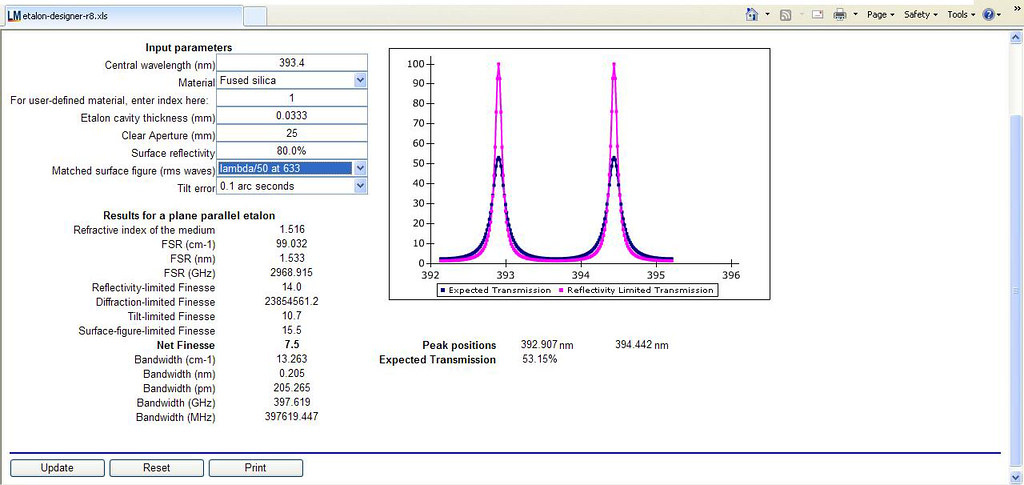
LM ETALON by Sullij1, on Flickr
Of note, back a few months ago when experimenting with trying to get better images of proms and filaments, Solar John (I think) suggested removing the Lunt conditioning filter barrel and use Baader film instead, to see if we could get better proms.
I conducted that experiment today with surprising results. It seems the Lunt back filter transmits light like regular glass with some something preventing proper focus – HMMMM, perhaps this is just an etalon and blocker and the front filters are the bandpass filters. The bifringence prevents a proper focus.
As I said a few months ago the Lunt conditioning fiters (in the barrel) look identical in color and split image (bifringent?), to Omega Bobs filters when held to the sun (the real 393.4 banpass at some wide FW, maybe 10nm with bifringent 1/2 wave plate).
This makes me think even more the lunt rear filter simply functions as a thin film etalon and blocker.
Here is the image:
SOFT
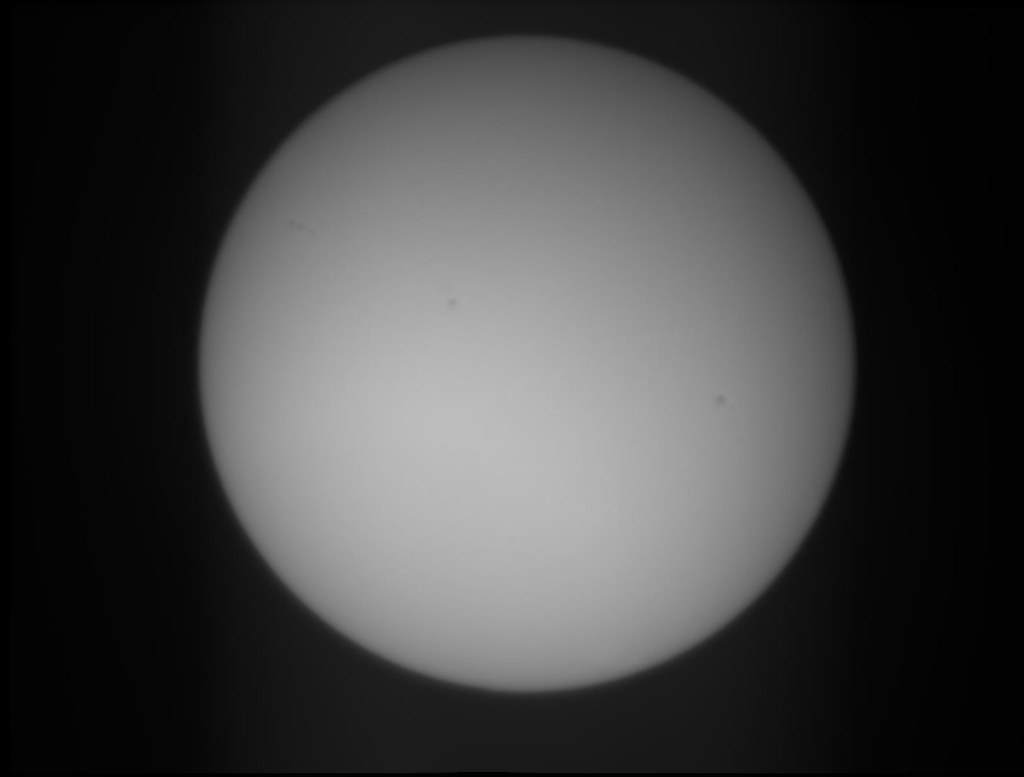
Lun back filter sun unprocessed by Sullij1, on Flickr
SHARP
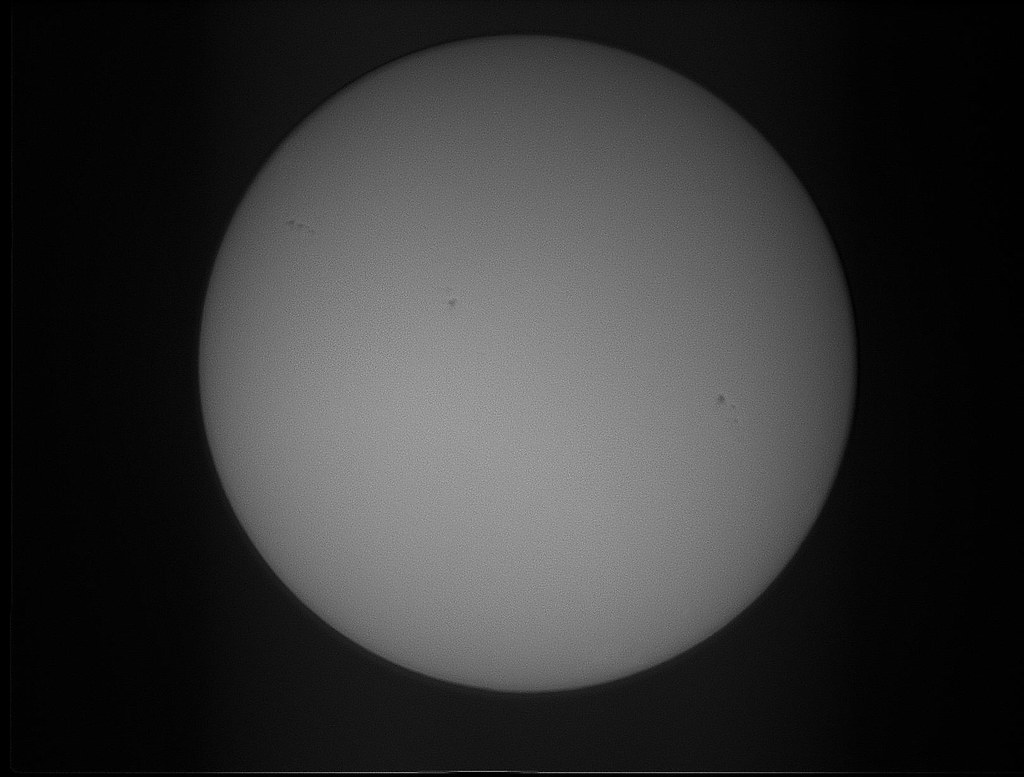
Lun back filter sun sharp by Sullij1, on Flickr
So attempting to reproduce this comparatively (when dealing with light it's all relative ) cheaply using the Bob filters, and mica ahead or behind or both in front and behind the bob filters seems worth it. Forming the reflective cavity at the rear will be the trick.
) cheaply using the Bob filters, and mica ahead or behind or both in front and behind the bob filters seems worth it. Forming the reflective cavity at the rear will be the trick.
Why? hows a A cheaper (~1/2 PRICE) B2000 or B3000 sound? Or a double stack for your main filter?
Note: This also this seems to be one source of the bared reflection I noted in previous posts. Perhaps caused by the bifringent reflections?
Again there is probably some things that I am not taking into account but a fused silica or mica gap of .0333mm or 33 micrometers gets us to a .205 nm or 2. Angstrom passband.
We might be able to do this with mica! It certainly validates that a single cavity deposition of a similar refractive index (RI) to include air, is possible. So an etalon the size we see in the Lunt back filter is entirely possible. A thin film coat with a similar RI could be used. So very interesting!
Here is the calc image (transmission 50%):

LM ETALON by Sullij1, on Flickr
Of note, back a few months ago when experimenting with trying to get better images of proms and filaments, Solar John (I think) suggested removing the Lunt conditioning filter barrel and use Baader film instead, to see if we could get better proms.
I conducted that experiment today with surprising results. It seems the Lunt back filter transmits light like regular glass with some something preventing proper focus – HMMMM, perhaps this is just an etalon and blocker and the front filters are the bandpass filters. The bifringence prevents a proper focus.
As I said a few months ago the Lunt conditioning fiters (in the barrel) look identical in color and split image (bifringent?), to Omega Bobs filters when held to the sun (the real 393.4 banpass at some wide FW, maybe 10nm with bifringent 1/2 wave plate).
This makes me think even more the lunt rear filter simply functions as a thin film etalon and blocker.
Here is the image:
SOFT

Lun back filter sun unprocessed by Sullij1, on Flickr
SHARP

Lun back filter sun sharp by Sullij1, on Flickr
So attempting to reproduce this comparatively (when dealing with light it's all relative
Why? hows a A cheaper (~1/2 PRICE) B2000 or B3000 sound? Or a double stack for your main filter?
Note: This also this seems to be one source of the bared reflection I noted in previous posts. Perhaps caused by the bifringent reflections?
Look Up!
- sullij1
- Way More Fun to Share It!!

- Posts: 2249
- Joined: Wed Mar 28, 2012 4:29 am
- Been thanked: 1 time
Re: A surprise in the LUNT CaK wedge
Ok, I left my digital micrometers at work but I have been reading a lot about cleaving mica and talking to folks at work. Electron micrope guys do this all the time.
We have a bunch of electron microscopes at the facility where I work. Talking to the SEM (scanning electron microscope) guys was fruitful. Not only did I get coaching on cleaving they mentioned being able to coat the mica if necessary.
Patience is key here. Once you have a corner of a razor in, just apply gentel pressure and wait. The mica will start to cleave itself! Just occasionaly apply enough pressure to keep the mica moving along the seperation joint. Stop lift, let it run/cleave and apply light pressure again. Before you know it, you will be cleaving away. I did 8 segments tonight. The first 4 just got rid of the top scratchy layers and then 4 more for clean, clear cleaves. Nothing to it! They said a person should be able to hand cleave to near 1 micron! So one should easily get the spacers and plates necessary. Here is a pic of some freshly cleaved chunks!
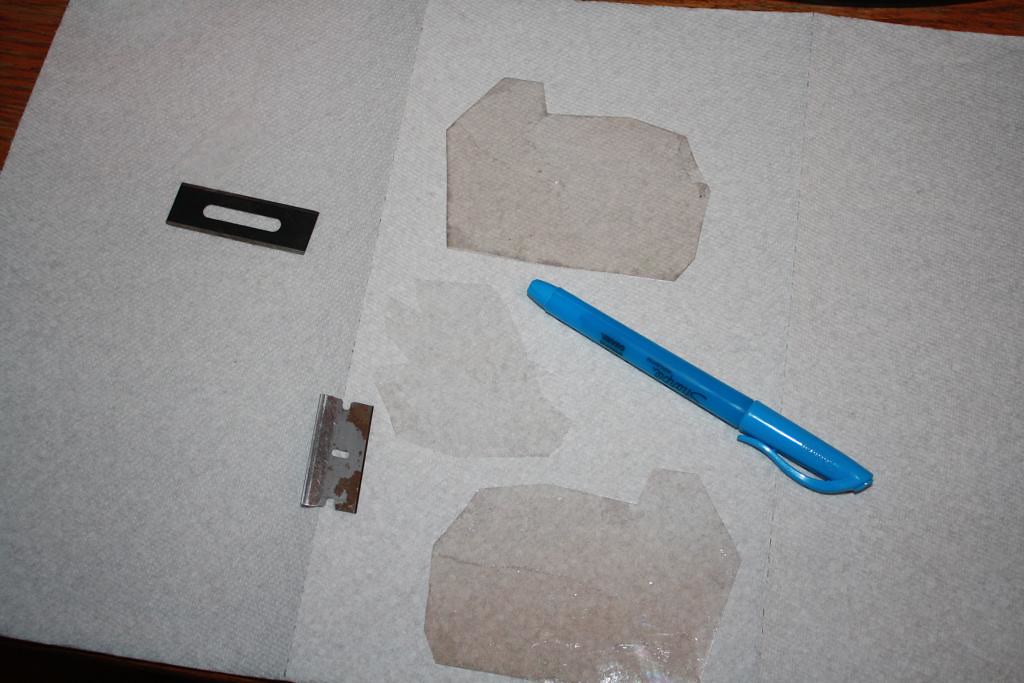
cleaved mica by Sullij1, on Flickr
WALTER this is for you.
Mark mentioned you also work at a well equipped lab. If you have SEM facilities, just ask the SEM guys to coat stuff for you. You might have to buy the coating disks but hey, "big deal". The SEM guys will probably have bench top coaters like the ones in the pics in the link I provide below. All you will have to do is measure the thickness. they should be able to help you establish the coat thickness necessary. Depending on size this may be a cheap and easy coating fix.
Here is the small coaters.
https://www.google.com/search?q=Scannin ... 80&bih=677
Best,
Joe
We have a bunch of electron microscopes at the facility where I work. Talking to the SEM (scanning electron microscope) guys was fruitful. Not only did I get coaching on cleaving they mentioned being able to coat the mica if necessary.
Patience is key here. Once you have a corner of a razor in, just apply gentel pressure and wait. The mica will start to cleave itself! Just occasionaly apply enough pressure to keep the mica moving along the seperation joint. Stop lift, let it run/cleave and apply light pressure again. Before you know it, you will be cleaving away. I did 8 segments tonight. The first 4 just got rid of the top scratchy layers and then 4 more for clean, clear cleaves. Nothing to it! They said a person should be able to hand cleave to near 1 micron! So one should easily get the spacers and plates necessary. Here is a pic of some freshly cleaved chunks!

cleaved mica by Sullij1, on Flickr
WALTER this is for you.
Mark mentioned you also work at a well equipped lab. If you have SEM facilities, just ask the SEM guys to coat stuff for you. You might have to buy the coating disks but hey, "big deal". The SEM guys will probably have bench top coaters like the ones in the pics in the link I provide below. All you will have to do is measure the thickness. they should be able to help you establish the coat thickness necessary. Depending on size this may be a cheap and easy coating fix.
Here is the small coaters.
https://www.google.com/search?q=Scannin ... 80&bih=677
Best,
Joe
Look Up!
- swisswalter
- Way More Fun to Share It!!

- Posts: 17948
- Joined: Thu Feb 06, 2014 4:28 am
- Location: Switzerland
- Been thanked: 1 time
- Contact:
Re: A surprise in the LUNT CaK wedge
Hi Joe
thank you very much. That is a good idea. We have to find out with what we should coat the mica an at what thickness
thank you very much. That is a good idea. We have to find out with what we should coat the mica an at what thickness
Only stardust in the wind, some fine and some less fine scopes, filters and adapters as well. Switzerland 47 N, 9 E, in the heart of EUROPE 
from 7 am - 7 pm http://www.nanosys.ch
from 7.01 pm - 6.59 am http://www.wastronomiko.com some times vice versa
from 7 am - 7 pm http://www.nanosys.ch
from 7.01 pm - 6.59 am http://www.wastronomiko.com some times vice versa
- sullij1
- Way More Fun to Share It!!

- Posts: 2249
- Joined: Wed Mar 28, 2012 4:29 am
- Been thanked: 1 time
Re: A surprise in the LUNT CaK wedge
Fell into a gold mine of trash today. One of our departments has a coating lab. I was there on biz today and the subject of coated mirror glass happened to come up (whistle). The techs told me I could help myself to any of the garbage coated glass plates they have. They are not uniform. So as the adage goes "one mans trash is another mans treasure". I found some mirror plates that may be just right for an etalon. One of the engineers has some experience with etalon fabrication and may be willing to chat with me from time to time. Whoo hoo! 
Anyway I helped myself to this fine piece of mirrored garbage. The high transmission areas of this plate may be just what the doctor ordered.
Here is a sample:

MIRROR by Sullij1, on Flickr
We shall see. I have more glass bobbles on the way in der post.
Anyway I helped myself to this fine piece of mirrored garbage. The high transmission areas of this plate may be just what the doctor ordered.
Here is a sample:

MIRROR by Sullij1, on Flickr
We shall see. I have more glass bobbles on the way in der post.
Look Up!
- sullij1
- Way More Fun to Share It!!

- Posts: 2249
- Joined: Wed Mar 28, 2012 4:29 am
- Been thanked: 1 time
Re: A surprise in the LUNT CaK wedge
BTW, I was reading some papers on multilayer thin film deposition of multiple etalon cavities and began wondering about the Lunt design. I wonder if the front filter is ERF/Polarizer then the second filter is initial multilayer bandpass at 394/ say .4nm and the rear filter is the high transmission final .4 cavities final cut and a blocker of some sort. this would eliminate all the cavities having to be applied to one filter.
Just a thought.
Just a thought.
Look Up!
- swisswalter
- Way More Fun to Share It!!

- Posts: 17948
- Joined: Thu Feb 06, 2014 4:28 am
- Location: Switzerland
- Been thanked: 1 time
- Contact:
Re: A surprise in the LUNT CaK wedge
Hi Joe
what a fine piece of trash ;-) We found out that the two up front filters are hot mirrors (blue sided), so the remaining filterstack must be the "finetuning" inclusive blocking
what a fine piece of trash ;-) We found out that the two up front filters are hot mirrors (blue sided), so the remaining filterstack must be the "finetuning" inclusive blocking
Only stardust in the wind, some fine and some less fine scopes, filters and adapters as well. Switzerland 47 N, 9 E, in the heart of EUROPE 
from 7 am - 7 pm http://www.nanosys.ch
from 7.01 pm - 6.59 am http://www.wastronomiko.com some times vice versa
from 7 am - 7 pm http://www.nanosys.ch
from 7.01 pm - 6.59 am http://www.wastronomiko.com some times vice versa
- marktownley
- Librarian

- Posts: 42559
- Joined: Tue Oct 18, 2011 5:27 pm
- Location: Brierley Hills, UK
- Has thanked: 20828 times
- Been thanked: 10502 times
- Contact:
Re: A surprise in the LUNT CaK wedge
Hi Joe, some great work going on there, I hope it all comes together for you!
I came across a couple of interesting PDFs I think the CaK fans will like about the scopes at the Paris Meudon observatory: My French is poor, but if I read it slow enough I can understand, I hope you can too, if anyone knows how to do a translate then please do...
With respect to the CaK filter things that caught my attention - the use of the KG5 as an ERF, secondly stopping down the scope to 70mm to give a particular cone angle which slightly blue shifts the original centre wavelength of the filter down to 393.37nm at a particular temperature (23c). I do find interesting the graph that shows the change of centre wavelength as a function of varying temperature and visually echoes what Mark Wagner has been telling us all about keeping the f-ratio slow to avoid thermal loading of the filter.
With respect to the CaH filter, it's interesting the importance that is again placed on the cone angle of the system and the slight but resultant blue shift that occurs to bring the filter to the centre line of CaH...
Hope these are of some use to you!
Mark
I came across a couple of interesting PDFs I think the CaK fans will like about the scopes at the Paris Meudon observatory: My French is poor, but if I read it slow enough I can understand, I hope you can too, if anyone knows how to do a translate then please do...
With respect to the CaK filter things that caught my attention - the use of the KG5 as an ERF, secondly stopping down the scope to 70mm to give a particular cone angle which slightly blue shifts the original centre wavelength of the filter down to 393.37nm at a particular temperature (23c). I do find interesting the graph that shows the change of centre wavelength as a function of varying temperature and visually echoes what Mark Wagner has been telling us all about keeping the f-ratio slow to avoid thermal loading of the filter.
With respect to the CaH filter, it's interesting the importance that is again placed on the cone angle of the system and the slight but resultant blue shift that occurs to bring the filter to the centre line of CaH...
Hope these are of some use to you!
Mark

http://brierleyhillsolar.blogspot.co.uk/
Solar images, a collection of all the most up to date live solar data on the web, imaging & processing tutorials - please take a look!
- sullij1
- Way More Fun to Share It!!

- Posts: 2249
- Joined: Wed Mar 28, 2012 4:29 am
- Been thanked: 1 time
Re: A surprise in the LUNT CaK wedge
I find it strange - not to say wrong - that the french opt for the uber expensive one shot CCD cameras. Ghristian Valdrich shoots with the SBIG 1100 (french). Never tried with my big CCD but I dont think I could get exposures short enough to get a properly exposed image.
I see the Barr filters are rated at .12nm instead of our .24nm and ~ theoretical .1 we have. Yet the imagery seems very nearly the same. Makes me feel better knowing that our 1200 dollar filters are bagging imaes that would cost 5-7 thousand USD if we were to buy the Barr Associates filter.
Thanks for the link Mark.
I see the Barr filters are rated at .12nm instead of our .24nm and ~ theoretical .1 we have. Yet the imagery seems very nearly the same. Makes me feel better knowing that our 1200 dollar filters are bagging imaes that would cost 5-7 thousand USD if we were to buy the Barr Associates filter.
Thanks for the link Mark.
Look Up!
- swisswalter
- Way More Fun to Share It!!

- Posts: 17948
- Joined: Thu Feb 06, 2014 4:28 am
- Location: Switzerland
- Been thanked: 1 time
- Contact:
Re: A surprise in the LUNT CaK wedge
Hi Mark, Hi Joe
thank you very much for the Information. You both have translated very well. There is not much more information in the papers. Except that they are using two KG3 in the case of the Ca H capture. The pics are fine but the pics Mark makes are finer :-) and that with a much lower priced filter system
thank you very much for the Information. You both have translated very well. There is not much more information in the papers. Except that they are using two KG3 in the case of the Ca H capture. The pics are fine but the pics Mark makes are finer :-) and that with a much lower priced filter system
Only stardust in the wind, some fine and some less fine scopes, filters and adapters as well. Switzerland 47 N, 9 E, in the heart of EUROPE 
from 7 am - 7 pm http://www.nanosys.ch
from 7.01 pm - 6.59 am http://www.wastronomiko.com some times vice versa
from 7 am - 7 pm http://www.nanosys.ch
from 7.01 pm - 6.59 am http://www.wastronomiko.com some times vice versa
- marktownley
- Librarian

- Posts: 42559
- Joined: Tue Oct 18, 2011 5:27 pm
- Location: Brierley Hills, UK
- Has thanked: 20828 times
- Been thanked: 10502 times
- Contact:
Re: A surprise in the LUNT CaK wedge
I've never used these expensive one shot cameras like the ones used at the Paris Meudon, but would be to see how they compare with stacked images from a video ccd in terms of signal to noise ratio etc.
My conclusion to date with CaK is that there is a benefit to double stacking CaK filters in terms of the extra contrast it gains and also allowing the proms to be fairly easily visible at this wavelength; in the case of the PST filters @ 2.2a a double stack pair effectively gets down to ~1.5a. However to narrow this further, I think triple stacking would be a no go as would drop light levels too low and would only drop the resultant bandpass down to ~1.3a, which I don't think would bring much gain in terms of detail. I think you need to get quite a bit below 1a to get the uber contrasty views with filaments visible, and that I feel is only available in the realm of the spectroscope folks. Or, etalon construction...
I think the next big step forward with CaK would be to identify the scopes that perform best at these short wavelengths - ie those with minimal spherical aberration at 393nm. We know of a couple, but we need to grow that list...
My conclusion to date with CaK is that there is a benefit to double stacking CaK filters in terms of the extra contrast it gains and also allowing the proms to be fairly easily visible at this wavelength; in the case of the PST filters @ 2.2a a double stack pair effectively gets down to ~1.5a. However to narrow this further, I think triple stacking would be a no go as would drop light levels too low and would only drop the resultant bandpass down to ~1.3a, which I don't think would bring much gain in terms of detail. I think you need to get quite a bit below 1a to get the uber contrasty views with filaments visible, and that I feel is only available in the realm of the spectroscope folks. Or, etalon construction...
I think the next big step forward with CaK would be to identify the scopes that perform best at these short wavelengths - ie those with minimal spherical aberration at 393nm. We know of a couple, but we need to grow that list...

http://brierleyhillsolar.blogspot.co.uk/
Solar images, a collection of all the most up to date live solar data on the web, imaging & processing tutorials - please take a look!
- marktownley
- Librarian

- Posts: 42559
- Joined: Tue Oct 18, 2011 5:27 pm
- Location: Brierley Hills, UK
- Has thanked: 20828 times
- Been thanked: 10502 times
- Contact:
Re: A surprise in the LUNT CaK wedge
OK fellas, the great Townley CaK experiment rolls on... Clear skies all day meant I had some time to have a mess around and explore, and took some pictures for you all to demonstrate the effect of spherical aberration on imaging in CaK wavelengths:
First off the full disk with the 40mm @ f20. Note, the reflection ' ghost is not thrown properly and look how much contrast we lose in this area - the proms are gone!
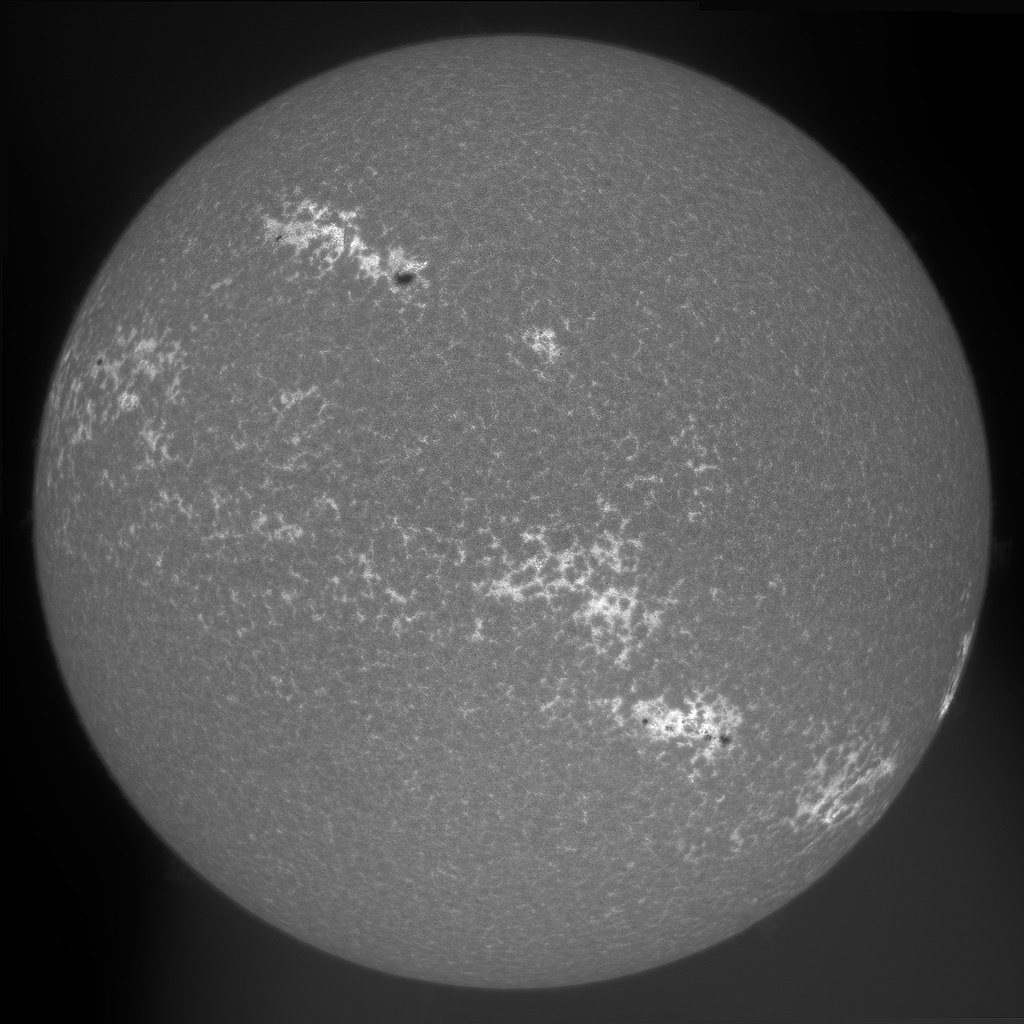
Cak-full-disk-bw-40mm-s by Mark Townley, on Flickr
Then I tried my 70mm f6 ED refractor, but stepping it down to 50mm, with the 2x barlow means its running at f16 to give this image scale. Note how we are losing contrast compared to original image above...
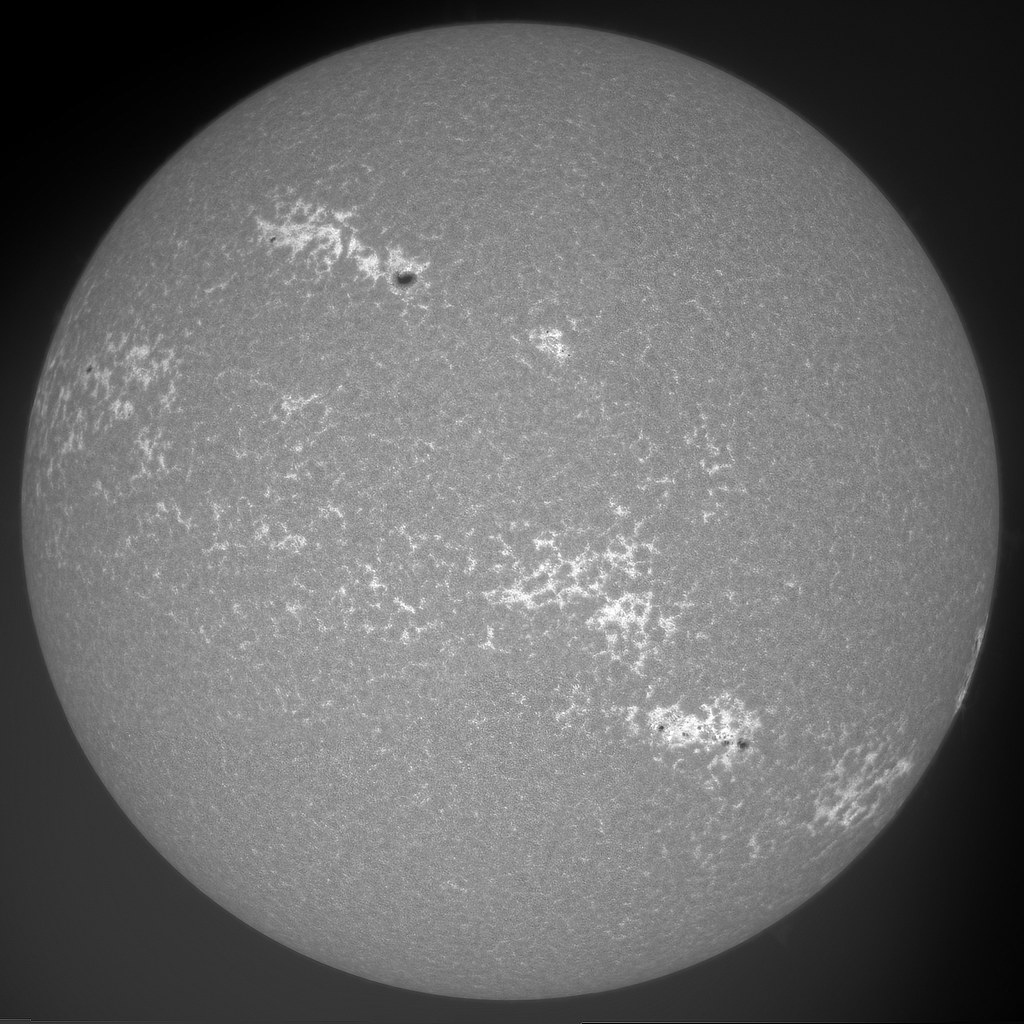
CaK-full-disk-50mm by Mark Townley, on Flickr
Finally, the 70mm at f12 (2x barlow again). There is less detail and considerably less contrast than the first image with the 40mm... Proms have vanished...
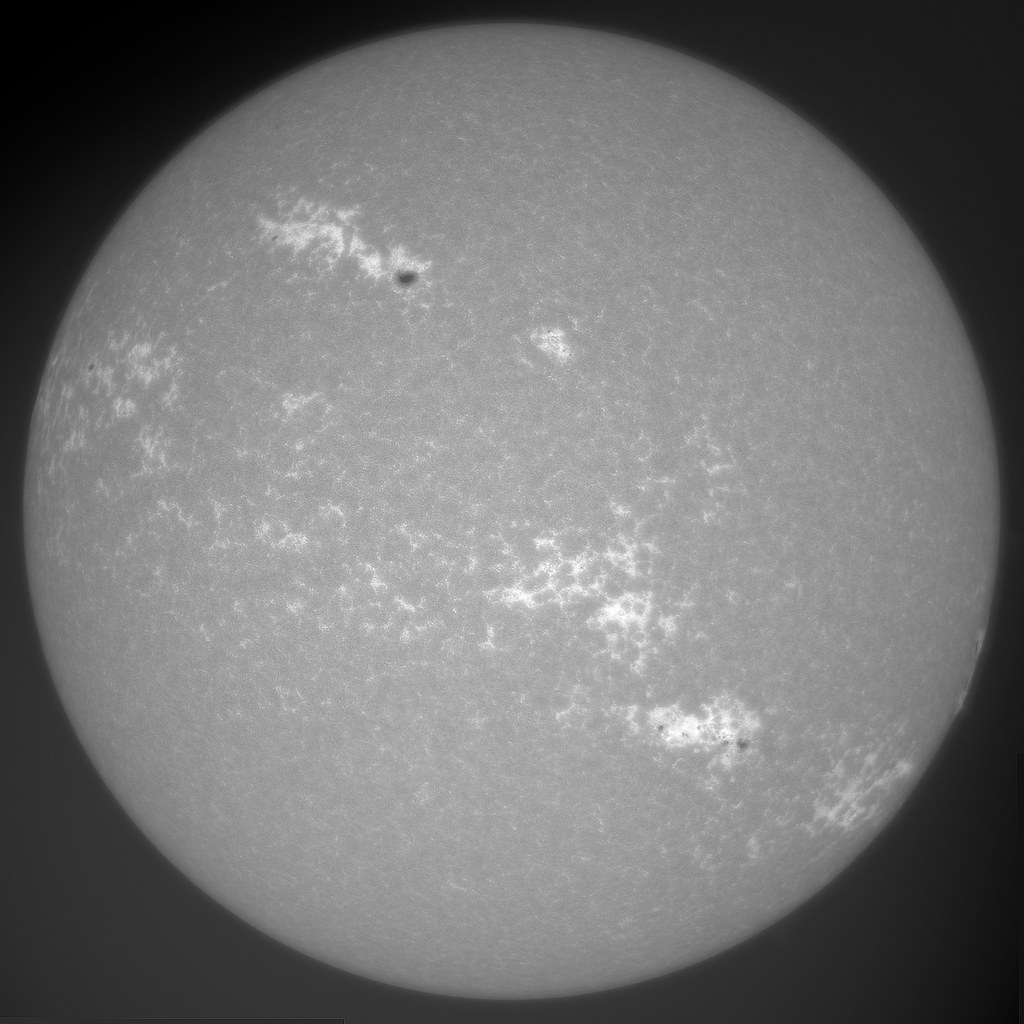
Cak-full-disk-70mm by Mark Townley, on Flickr
Considering this is the same filter we are running here, to me, the key thing this shows is how the spherical aberration of the scope destroys things in CaK! Something to bear in mind when choosing the scopes we use at these short wavelengths.
Hope you find the comparison useful!
Mark
First off the full disk with the 40mm @ f20. Note, the reflection ' ghost is not thrown properly and look how much contrast we lose in this area - the proms are gone!

Cak-full-disk-bw-40mm-s by Mark Townley, on Flickr
Then I tried my 70mm f6 ED refractor, but stepping it down to 50mm, with the 2x barlow means its running at f16 to give this image scale. Note how we are losing contrast compared to original image above...

CaK-full-disk-50mm by Mark Townley, on Flickr
Finally, the 70mm at f12 (2x barlow again). There is less detail and considerably less contrast than the first image with the 40mm... Proms have vanished...

Cak-full-disk-70mm by Mark Townley, on Flickr
Considering this is the same filter we are running here, to me, the key thing this shows is how the spherical aberration of the scope destroys things in CaK! Something to bear in mind when choosing the scopes we use at these short wavelengths.
Hope you find the comparison useful!
Mark

http://brierleyhillsolar.blogspot.co.uk/
Solar images, a collection of all the most up to date live solar data on the web, imaging & processing tutorials - please take a look!
- swisswalter
- Way More Fun to Share It!!

- Posts: 17948
- Joined: Thu Feb 06, 2014 4:28 am
- Location: Switzerland
- Been thanked: 1 time
- Contact:
Re: A surprise in the LUNT CaK wedge
Hi Mark
thank you for showing us that. I hope I can add some pics from a Unitron (102/1500) soon ;-)
thank you for showing us that. I hope I can add some pics from a Unitron (102/1500) soon ;-)
Only stardust in the wind, some fine and some less fine scopes, filters and adapters as well. Switzerland 47 N, 9 E, in the heart of EUROPE 
from 7 am - 7 pm http://www.nanosys.ch
from 7.01 pm - 6.59 am http://www.wastronomiko.com some times vice versa
from 7 am - 7 pm http://www.nanosys.ch
from 7.01 pm - 6.59 am http://www.wastronomiko.com some times vice versa